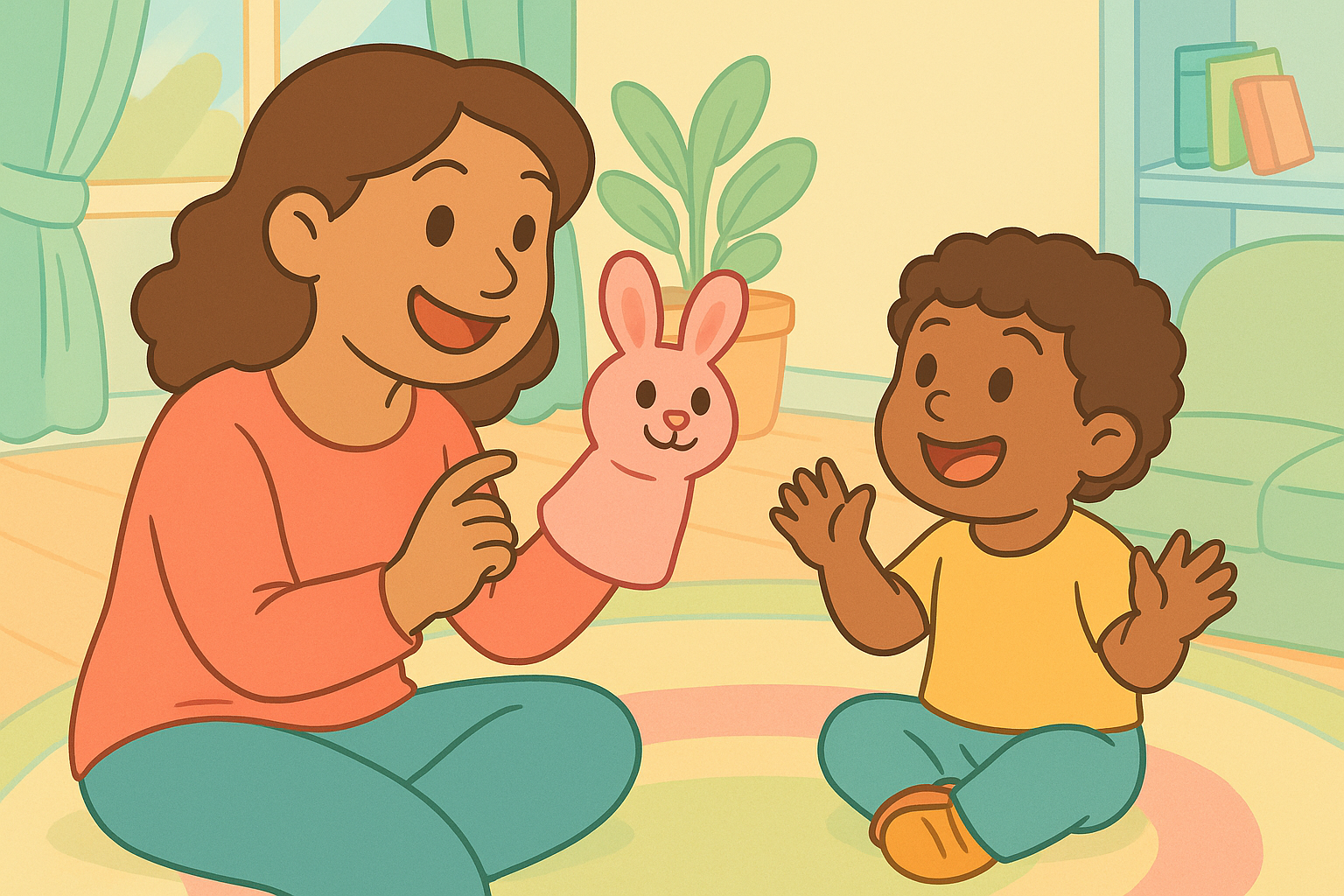Using Puppet Conversations to Teach Vocabulary
Using Puppet Conversations to Teach Vocabulary
Why Puppets Are Powerful Language Teachers
When a puppet starts talking, children listen. They giggle, respond, and often open up in ways they don’t with adults.
That’s the magic of puppet play — it combines storytelling, imagination, and language in one joyful package.
The Science Behind Learning Through Play
Language development thrives on interaction. When children hear and use new words in playful, emotional contexts, those words stick in long-term memory.
Puppet play activates three key brain systems:
Social connection: Kids feel like they’re chatting with a friend, not “being taught.”
Repetition and rhythm: Reinforcing new words through songs and stories.
Visual and emotional engagement: Helping kids attach meaning and feeling to each word.
This is why puppet conversations are such a powerful bridge between fun and foundational literacy.
(Also see: Developing Listening Skills Through Storytelling)
Step 1: Choose Your Puppet Partner
You don’t need a fancy puppet — a sock with googly eyes or a paper bag face works perfectly.
What matters is that the puppet has personality and consistency.
Give it a name, voice, and distinct quirks. Maybe it’s shy, silly, forgetful, or curious — these traits keep kids engaged and coming back for more.
(Also see: Puppet Games for Early Language Development)
Step 2: Let the Puppet Do the Talking
Children love when puppets “take the lead.”
You might start with simple introductions:
Puppet: “Hi there! I’m Benny the Bunny. What’s your name?”
Child: answers
Puppet: “Nice to meet you! Do you like carrots or cookies?”
That’s it — a natural back-and-forth conversation. As your child responds, you’re encouraging spontaneous speech and new word use.
Step 3: Introduce New Words in Context
Vocabulary grows fastest when new words are embedded in real play.
Use the puppet to explore themed words naturally:
During snack time: “Mmm, these crunchy carrots are delicious!”
During pretend play: “Let’s build a tall tower! Oh no, it’s wobbly!”
During nature walks: “Look! A tiny bug on a smooth leaf!”
Hearing words in action helps children understand both meaning and tone.
Step 4: Use Repetition With Variation
Children need to hear new words multiple times before they “own” them.
Have your puppet repeat key words naturally through different situations:
“Let’s build a bridge today!”
“Our bridge is falling down!”
“Can you fix the bridge with blocks?”
Each variation deepens understanding without feeling repetitive.
(Also see: Why Repetition and Routine Boost Learning Retention)
Step 5: Encourage Turn-Taking and Listening
Use your puppet to model conversational turn-taking — a critical pre-reading and social skill.
Puppet: “I’ll say something, then it’s your turn!”
“My favorite fruit is an apple. What’s your favorite?”
This rhythm teaches pacing, listening, and expressive language.
(Also see: How to Encourage Turn-Taking During Learning Games)
Step 6: Make It Interactive and Physical
Combine puppet play with movement to activate more areas of the brain.
Try:
Pointing to items the puppet describes (“Find something round!”)
Acting out story verbs (“Let’s jump, stomp, and wave!”)
Using gesture cues when introducing adjectives (“Big!” spreads arms wide)
The more senses involved, the faster the vocabulary sticks.
Step 7: Let Your Child Lead the Conversation
As children get more confident, hand them the puppet and let them take over.
“What does your puppet want to say today?”
When kids “speak” through a puppet, they feel freer to experiment with language and storytelling. They’re practicing sentence structure, tone, and dialogue — all while playing.
(Also see: Encouraging Creative Thinking Through Open-Ended Play)
Step 8: Add Puppets to Storytime
Bring stories to life by giving each puppet a role.
If you’re reading The Three Little Pigs, let your puppet huff and puff or squeal in surprise. You can pause and ask:
“What should the puppet do next?”
This invites prediction, sequencing, and emotional awareness — all key pre-literacy skills.
Step 9: Use Puppets for Emotional Vocabulary
Puppets are also wonderful for teaching the language of feelings.
“Max the Mouse is worried about trying something new. What could help him feel better?”
By naming emotions through a puppet, kids learn empathy and vocabulary at the same time.
Step 10: Create Puppet Word Games
Keep sessions short and joyful. Here are a few simple favorites:
“The Silly Word Swap”
Puppet says the wrong word on purpose (“I’m wearing spaghetti on my feet!”). Kids correct it, laughing while reinforcing vocabulary.
“What’s in My Bag?”
Hide small objects in a bag and have the puppet describe them:
“It’s round, red, and crunchy…” (apple)
“Opposite Chat”
Puppet: “I’m tall today!”
Child: “Then I’m short!”
(Also see: How to Teach Opposites Through Play)
Step 11: Keep It Short, Consistent, and Fun
Five minutes of puppet talk a day can make a big difference — consistency matters more than length.
Keep the tone light and full of laughter. Your puppet doesn’t need perfect grammar or fancy words — just warmth, energy, and curiosity.
When Puppets Help Reluctant Talkers
Some children are naturally shy or slow to speak. Puppets offer a safe emotional distance. Kids often project their feelings through the puppet first — saying things they’re not yet ready to express themselves.
That’s language growth, empathy, and emotional regulation in motion.
(Also see: Helping Late Talkers Build Confidence Through Play)
This content is for educational purposes and is not a substitute for professional medical or psychological advice.
Popular Parenting Articles




